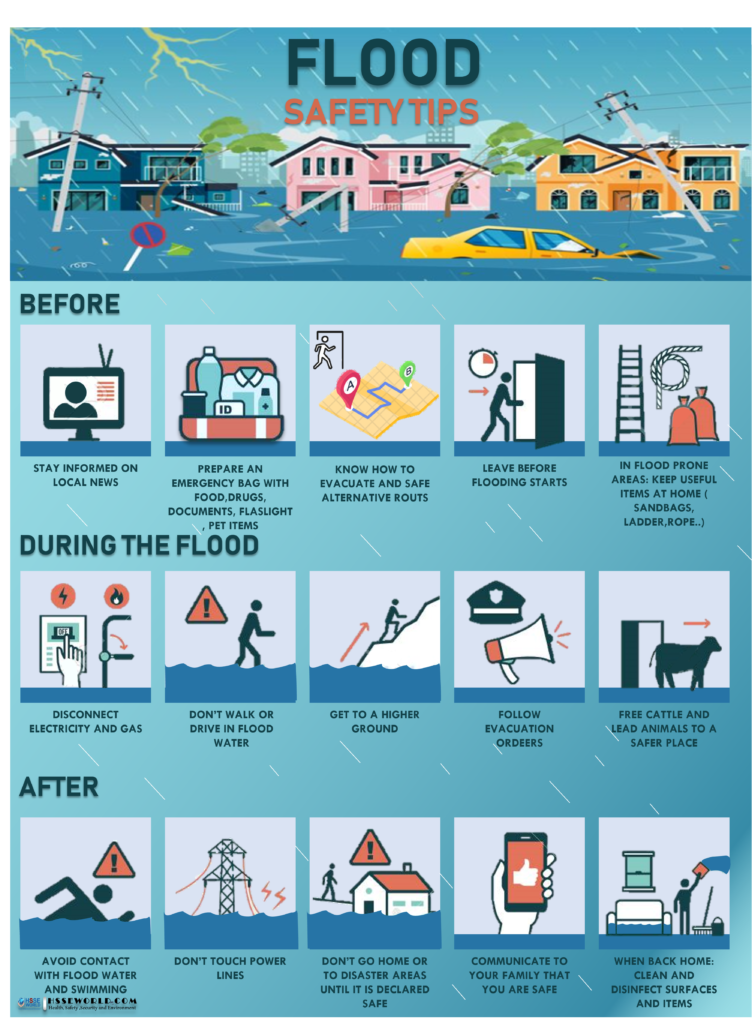How To Survive A Flash Flood Emergency: Essential Safety Measures

Table of Contents
Understanding Flash Flood Risks and Warnings
Flash floods are sudden, rapid floods that occur within six hours of the causative event, most often heavy or prolonged rainfall. However, other factors can contribute to flash floods, including:
- Heavy rainfall: Intense downpours, especially over saturated ground, can overwhelm drainage systems, leading to rapid water accumulation. This is a primary cause of flash floods, particularly in mountainous or urban areas with inadequate drainage infrastructure.
- Dam failures or levee breaches: Breaches in dams or levees can release massive amounts of water in a short period, causing catastrophic flash flooding downstream. This necessitates constant maintenance and monitoring of these structures.
- Sudden snowmelt: Rapid snowmelt, especially during spring thaws or warm spells, can rapidly increase water levels in rivers and streams, triggering flash floods. This risk is especially high in regions with significant snowfall.
- Mudslides and debris flows: Mudslides and debris flows triggered by heavy rainfall can block waterways, causing water to back up and overflow, leading to devastating flash floods.
Monitoring weather forecasts and alerts is crucial for flash flood preparedness. Reliable sources include:
- The National Weather Service (NWS): The NWS provides accurate and timely weather forecasts and warnings, including flash flood watches, warnings, and advisories.
- Local news: Local news channels and websites often provide up-to-the-minute weather updates and reports on local flooding situations.
Key Actions:
- Sign up for emergency alerts on your phone through your local emergency management agency or weather service app.
- Know your evacuation routes in advance and plan multiple escape routes depending on where the flash flood may occur.
- Understand the different levels of flash flood warnings (watch, warning, advisory) and know what actions to take for each level.
- Recognize the early signs of a flash flood: rapidly rising water levels in streams or rivers, overflowing streams, and unusually strong currents.
Preparing for a Flash Flood Emergency
Proactive preparation is key to surviving a flash flood. This includes:
- Developing a family emergency plan: Establish a communication plan, designate a meeting point outside the flood zone, and identify roles and responsibilities for each family member.
- Creating a go-bag: Pack a bag with essential supplies for at least 72 hours, including water, non-perishable food, first-aid kit, flashlight, batteries, medications, important documents, and a whistle.
- Identifying safe evacuation routes and locations: Determine the nearest high ground or designated evacuation shelters. Knowing where to go in advance saves precious time during an emergency.
Essential Preparedness Steps:
- Locate the nearest high ground in your area – this could be a hill, elevated building, or higher floor.
- Know the location of your local emergency shelters and the routes to reach them.
- Ensure your car is fueled up and ready to go at a moment's notice.
- Secure important documents and valuables in waterproof containers or move them to upper floors of your home.
Actions to Take During a Flash Flood
When a flash flood warning is issued, act immediately.
- Immediate evacuation: If instructed to evacuate, do so immediately. Do not delay. Flash floods can rise incredibly rapidly.
- Trapped in a vehicle: If your vehicle is caught in floodwaters, abandon it immediately and move to higher ground. Floodwaters can quickly sweep away cars.
- Trapped in a building: If trapped in a building, move to the highest floor or the roof. Seek refuge in an interior room on an upper floor or the attic and call emergency services.
Critical Actions to Avoid:
- Never attempt to drive through a flooded area: Even a few inches of water can cause a vehicle to lose control or stall. The depth of water can be deceiving.
- Do not walk or hike in floodwaters: Floodwaters can be contaminated with dangerous debris, chemicals, and sewage. The current can be stronger than it appears.
- Stay away from power lines and downed electrical wires: These are extremely dangerous and can cause electrocution.
- Avoid areas prone to flooding: Know your area's flood-prone zones and avoid these areas during heavy rainfall.
- Listen to official instructions and follow directions from emergency responders: They are your best source of information and guidance during a flash flood.
Protecting Your Home Before and During a Flash Flood
Taking preventative steps can minimize damage to your home.
- Before a flash flood: Clean gutters and downspouts regularly to ensure proper drainage. Move valuable items and electronics to upper floors.
- During a flash flood: Turn off utilities (gas, electricity), move to higher ground, and install flood barriers or sandbags if time permits.
Home Protection Measures:
- Install flood barriers or sandbags around your home's foundation to prevent water from entering.
- Protect your home's foundation from water damage by sealing cracks and ensuring proper drainage.
Post-Flash Flood Safety and Recovery
Returning to a flooded area can be dangerous.
- Wait for the all-clear: Do not return to flooded areas until officials deem it safe. Floodwaters often contain hidden dangers.
- Cleaning and sanitizing: Thoroughly clean and sanitize affected areas to prevent waterborne diseases. Use protective gear during cleanup.
- Reporting damages: Report damages to your insurance company and local authorities to seek assistance with recovery.
Post-Flood Safety Precautions:
- Watch out for broken glass, debris, and downed power lines.
- Be aware of the risk of waterborne diseases and take necessary precautions.
- Document flood damage with photos and videos for insurance claims.
Conclusion
Surviving a flash flood requires preparedness, quick thinking, and a respect for the power of nature. By following these essential safety measures, you significantly increase your chances of surviving a flash flood emergency and minimizing the impact on your life and property. Remember, your safety is paramount. Stay informed, prepare diligently, and act decisively when a flash flood warning is issued. Learn more about flash flood preparedness and develop your personal action plan to stay safe from the dangers of a flash flood and subsequent flash flood damage.

Featured Posts
-
 Ex Israeli Soldiers Advocate For Release Of Gaza Captive
May 26, 2025
Ex Israeli Soldiers Advocate For Release Of Gaza Captive
May 26, 2025 -
 Berikut Klasemen Moto Gp Usai Kemenangan Sprint Race Marc Marquez Di Argentina 2025
May 26, 2025
Berikut Klasemen Moto Gp Usai Kemenangan Sprint Race Marc Marquez Di Argentina 2025
May 26, 2025 -
 Hakem Takla Atti Atletico Madrid In Espanyol Macindaki Skandali
May 26, 2025
Hakem Takla Atti Atletico Madrid In Espanyol Macindaki Skandali
May 26, 2025 -
 Understanding Russell And The Typhoons A Comprehensive Guide
May 26, 2025
Understanding Russell And The Typhoons A Comprehensive Guide
May 26, 2025 -
 Top Nike Running Shoes For 2025 Performance And Style
May 26, 2025
Top Nike Running Shoes For 2025 Performance And Style
May 26, 2025
Latest Posts
-
 Comparatif Smartphones Le Samsung Galaxy S25 128 Go A 648 E En Valeur
May 28, 2025
Comparatif Smartphones Le Samsung Galaxy S25 128 Go A 648 E En Valeur
May 28, 2025 -
 Offre Limitee Galaxy S25 Ultra 256 Go 5 Etoiles 1196 50 E
May 28, 2025
Offre Limitee Galaxy S25 Ultra 256 Go 5 Etoiles 1196 50 E
May 28, 2025 -
 Vente Flash Samsung Galaxy S25 Ultra 256 Go 5 Etoiles A 1196 50 E
May 28, 2025
Vente Flash Samsung Galaxy S25 Ultra 256 Go 5 Etoiles A 1196 50 E
May 28, 2025 -
 Ou Acheter Le Samsung Galaxy S25 128 Go Au Meilleur Prix
May 28, 2025
Ou Acheter Le Samsung Galaxy S25 128 Go Au Meilleur Prix
May 28, 2025 -
 Smartphone Samsung Galaxy S25 128 Go Un Top Produit A 648 E
May 28, 2025
Smartphone Samsung Galaxy S25 128 Go Un Top Produit A 648 E
May 28, 2025
